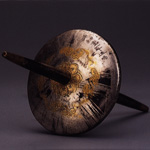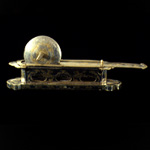Home > Teach me Tea Cha! > History > Tea culture in Tang Dynasty
Main content starts here.
Tea culture in Tang Dynasty



(Tang Dynasty A.D.618-690, 705-907) In the informational book about tea "Chajin" written by LuYu in 760, four types of teas- sucha, sancha, mucha,and bincha" are mentioned. All teas are steam processed in order to stop them from fermentation. Japanese green teas can be grouped in this category. Among those 4 types of tea, Bincha has most complicated process as follow: 1. Picking, 2. Steaming 3. Grinding 4. Compressing 5. Drying under the sun 6. Skewered and baked 7. Placed in the container and stored. The form of tea was very different from the loose leaves, what we normally use today. It was stiff, and compressed hardly. This compressed tea was drank by following procedure: 1. Roasting 2. Placed in the paper bag to cool 3. Grinding 4. Brewing in the hot water which had added some salt 5. Pour in the cup and drink The idea of adding salt in the tea has a connection to the ancient way of drinking tea, which was drank more like a soup. Tea was used to be a one of the ingredients for cooking. To make bincha, more attention needed to pay for the process, and because of its complicated process, bincha became a variable tea and often used for the tribulation to the imperial court. At the imperial court, the elegant porcelain tea cups and grass cups were used for serving and drinking. Intellectuals at this time of the period also enjoyed the tea party, and left many poems and prose praising about tea. From one of those poems we can tell that color of tea people drank at the time was light yellow. The written evidence of tea "Fengsiwenjianji" which was written by LuYi and FenYan tells that tea was widely drank in all social leveled people during the Tang dynasty. People in general had probably drank some kind of simple processed tea. During the Tang dynasty, the soup style of tea from Hang dynasty was still drank by some people. LuYu was criticizing this way of drinking tea in his book Chajin and emphasized the simple way to enjoy the tea without adding anything. The Tang dynasty is also the time that tea production had increased greatly to meet the high demand for all social leveled people.
(Miwako Saitou)
